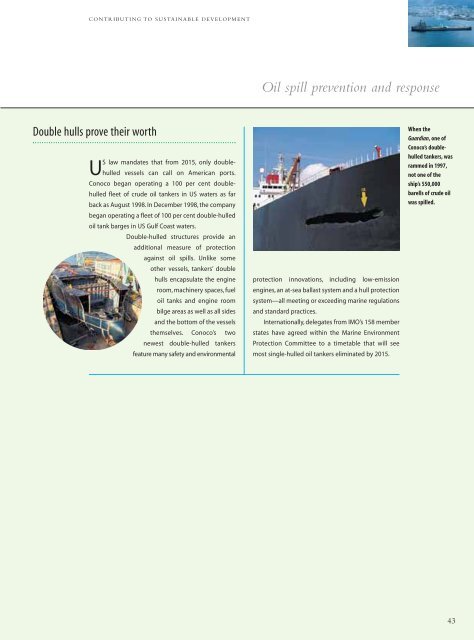WSSD Report FINAL! - OGP
WSSD Report FINAL! - OGP
WSSD Report FINAL! - OGP
You also want an ePaper? Increase the reach of your titles
YUMPU automatically turns print PDFs into web optimized ePapers that Google loves.
CONTRIBUTING TO SUSTAINABLE DEVELOPMENT<br />
Oil spill prevention and response<br />
Double hulls prove their worth<br />
US law mandates that from 2015, only doublehulled<br />
vessels can call on American ports.<br />
Conoco began operating a 100 per cent doublehulled<br />
fleet of crude oil tankers in US waters as far<br />
back as August 1998. In December 1998, the company<br />
began operating a fleet of 100 per cent double-hulled<br />
oil tank barges in US Gulf Coast waters.<br />
Double-hulled structures provide an<br />
additional measure of protection<br />
against oil spills. Unlike some<br />
other vessels, tankers’ double<br />
hulls encapsulate the engine<br />
room, machinery spaces, fuel<br />
oil tanks and engine room<br />
bilge areas as well as all sides<br />
and the bottom of the vessels<br />
themselves. Conoco’s two<br />
newest double-hulled tankers<br />
feature many safety and environmental<br />
protection innovations, including low-emission<br />
engines, an at-sea ballast system and a hull protection<br />
system—all meeting or exceeding marine regulations<br />
and standard practices.<br />
Internationally, delegates from IMO’s 158 member<br />
states have agreed within the Marine Environment<br />
Protection Committee to a timetable that will see<br />
most single-hulled oil tankers eliminated by 2015.<br />
When the<br />
Guardian,one of<br />
Conoco’s doublehulled<br />
tankers, was<br />
rammed in 1997,<br />
not one of the<br />
ship’s 550,000<br />
barells of crude oil<br />
was spilled.<br />
43

















